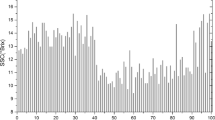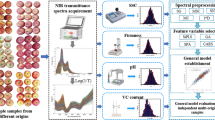Abstract
Hardness is one of the most important quality characteristics, which has an important influence on the processing and product quality of figs. A rapid non-destructive detection method for the hardness of figs was proposed based on visible/near infrared (VIS/NIR) spectroscopy technology. This study attempts to optimize the construction of a fig hardness model and predict the accuracy of thereof. An NIR spectrometer was used to collect the diffuse reflectance spectrum data in the wavelength range of 950–1700 nm, while the hardness index was measured using texture analyzer. Random forest (RF) and partial least square (PLS) methods were used to model the spectral data and hardness, respectively, and a better algorithm for the model construction was obtained. The RF model performed better in the characteristic band (1150.83–1232.43 nm), with correlation coefficient (R2), root mean square error of calibration (RMSEC), and root mean square error of prediction (RMSEP) of 0.76, 67.61, and 83.94 respectively. The PLS model worked well at the full band (R2 = 0.77, RMSEC = 59.20, RMSEP = 91.84). However, the prediction time of the PLS was slightly shorter than that of RF model (0.0004 s < 0.0098 s). The results show that it is feasible to detect the hardness of figs without destroying them by using VIS/NIR diffuse reflectance spectroscopy combined with sample set partitioning based on joint x–y distances (SPXY), RF, and PLS algorithms. This study provides new technical means for fig products enterprises to determine the hardness of figs in the early stages of production rapidly and evaluate the processing quality of fig products, which has a high practical application potential.






Similar content being viewed by others
References
Abualigah LM (2020) Multi-verse optimizer algorithm: a comprehensive survey of its results, variants, and applications. Neural Comput Appl 32(16):12381–12401. https://doi.org/10.1007/s00521-020-04839-1
Abualigah LM, Khader AT (2017) Unsupervised text feature selection technique based on hybrid particle swarm optimization algorithm with genetic operators for the text clustering. J Supercomput 73(11):1–23. https://doi.org/10.1007/s11227-017-2046-2
Awanthi MGG, Jinendra BMS, Navaratne SB, Navaratne CM (2019) Adaptation of visible and short wave Near Infrared (VIS-SW-NIR) common PLS model for quantifying paddy hardness. J Cereal Sci 89:102795. https://doi.org/10.1016/j.jcs.2019.102795
Begum R, Yusof YA, Aziz MG, Uddin MB (2017) Structural and functional properties of pectin extracted from jackfruit (Artocarpus heterophyllus) waste: Effects of drying. Int J Food Prop 190–201. https://doi.org/10.1080/10942912.2017.1295054
Berardinelli A, Benelli A, Tartagni M, Ragni L (2019) Kiwifruit flesh firmness determination by a NIR sensitive device and image multivariate data analyses. Sensors Actuators A: Phys 296:265–271. https://doi.org/10.1016/j.sna.2019.07.027
Conesa MR, García-Salinas MD, Rosa JMDL, Fernández-Trujillo JP, Domingo R, Pérez-Pastor A (2014) Effects of deficit irrigation applied during fruit growth period of late mandarin trees on harvest quality, cold storage and subsequent shelf-life. Sci Hort 165(3):344–351. https://doi.org/10.1016/j.scienta.2013.11.023
Debib A, Dueñas M, Boumediene M, Mothana RA, Latifa A, Tir-Touil MA (2016) Synergetic hepatoprotective effect of phenolic fractions obtained from ficus carica dried fruit and extra virgin olive oil on CCL4-induced oxidative stress and hepatotoxicity in rats. J Food Biochem 40(4):507–516. https://doi.org/10.1111/jfbc.12241
Ghnimi S, Al-Shibli M, Al-Yammahi HR, Al-Dhaheri A, Al-Jaberi F, Jobe B, Kamal-Eldin A (2018) Reducing sugars, organic acids, size, color, and texture of 21 Emirati date fruit varieties (Phoenix dactylifera, L.). NFS J 12:1–10. https://doi.org/10.1016/j.nfs.2018.04.002
Huang YP, Lu RF, Chen KJ (2018) Prediction of firmness parameters of tomatoes by portable visible and near-infrared spectroscopy. J Food Eng 222:185–198. https://doi.org/10.1016/j.jfoodeng.2017.11.030
Ibáñez G, Cebolla-Cornejo J, Martí R, Roselló S, Valcárcel M (2019) Non-destructive determination of taste-related compounds in tomato using NIR spectra. J Food Eng 263:237–242. https://doi.org/10.1016/j.jfoodeng.2019.07.004
Kashash Y, Mayuoni-Kirshenbaum L, Goldenberg L, Choi HJ, Porat R (2016) Effects of harvest date and low-temperature conditioning on chilling tolerance of “Wonderful” pomegranate fruit. Sci Hort 209:286–292. https://doi.org/10.1016/j.scienta.2016.06.038
Lansky EP, Paavilainen HM, Pawlus AD, Newman RA (2015) Ficus spp. (fig): Ethnobotany and potential as anticancer and anti-inflammatory agents. J Ethnopharmacol 119(2):195–213. https://doi.org/10.1016/j.jep.2008.06.025
Li JB, Huang WQ, Zhao CJ, Zhang BH (2013) A comparative study for the quantitative determination of soluble solids content, pH and firmness of pears by Vis/NIR spectroscopy. J Food Eng 116(2):324–332. https://doi.org/10.1016/j.jfoodeng.2012.11.007
Li GH, Ren YM, Ren XL, Zhang XR (2015) Non-destructive measurement of fracturability and chewiness of apple by FT-NIRS. J Food Sci Technol 52(1):258–266. https://doi.org/10.1007/s13197-013-0990-2
Li S, Luo H, Hu M, Zhang M, Feng J, Liu Y, Dong Q, Liu B (2019) Optical non-destructive techniques for small berry fruits: A review. Artif Intell Agric 2:85–98. https://doi.org/10.1016/j.aiia.2019.07.002
Li JB, Zhang HL, Zhan BS, Zhang YF, Li RL, Li JB (2019) Nondestructive firmness measurement of the multiple cultivars of pears by Vis-NIR spectroscopy coupled with multivariate calibration analysis and MC-UVE-SPA method. Infrared Phys Technol 104:103154. https://doi.org/10.1016/j.infrared.2019.103154
Nturambirwe JFI, Opara UL (2020) Machine learning applications to non-destructive defect detection in horticultural products. Biosys Eng 189:60–83. https://doi.org/10.1016/j.biosystemseng.2019.11.011
Patil R, Joshi GD, Haldankar PM, More M (2011) Estimation of pectin content in jackfruit (Artocarpus heterophyllus). Asian J Holtic 6(2):536–537
Paulsen M, Rasmussen TK, Nielsen OA (2018) Output variability caused by random seeds in a multi-agent transport simulation model. Procedia Comput Sci 130:850–857. https://doi.org/10.1016/j.procs.2018.04.078
Raafat K, Wurglics M (2019) Phytochemical analysis of Ficus carica L. active compounds possessing anticonvulsant activity. J Tradit Complement Med 9:263–270. https://doi.org/10.1016/j.jtcme.2018.01.007
Reyes-Avalos MC, Minjares-Fuentes R, Femenia A, Contreras-Esquivel JC, Quintero-Ramos A, Esparza-Rivera JR, Meza-Velázquez JA (2019) Application of an alginate–chitosan edible film on figs (Ficus carica): Effect on bioactive compounds and antioxidant capacity. Food Bioprocess Technol 12:499–511. https://doi.org/10.1007/s11947-018-2226-y
Rungpichayapichet P, Mahayothee B, Nagle M, Khuwijitjaru P, Müller J (2016) Robust NIRS models for non-destructive prediction of postharvest fruit ripeness and quality in mango. Postharvest Biol Technol 111:31–40. https://doi.org/10.1016/j.postharvbio.2015.07.006
Saad A, Jha SN, Jaiswal P, Srivastava N, Helyes L (2016) Non-destructive quality monitoring of stored tomatoes using VIS-NIR spectroscopy. Eng Agric Environ Food 9(2):158–164. https://doi.org/10.1016/j.eaef.2015.10.004
Sanchez PDC, Hashim N, Shamsudin R, Mohd Nor MZ (2020) Applications of imaging and spectroscopy techniques for non-destructive quality evaluation of potatoes and sweet potatoes: A review. Trends Food Sci Technol 96:208–221. https://doi.org/10.1016/j.tifs.2019.12.027
Santos Pereira LF, Barbon S, Valous NA, Barbin DF (2018) Predicting the ripening of papaya fruit with digital imaging and random forests. Comput Electron Agric 145:76–82. https://doi.org/10.1016/j.compag.2017.12.029
Sun J, Künnemeyer R, McGlone A, Rowe P (2016) Multispectral scattering imaging and NIR interactance for apple firmness predictions. Postharvest Biol Technol 119:58–68. https://doi.org/10.1016/j.postharvbio.2016.04.019
Sun M, Zhang D, Liu L, Wang Z (2017) How to predict the sugariness and hardness of melons: A near-infrared hyperspectral imaging method. Food Chem 218:413–421. https://doi.org/10.1016/j.foodchem.2016.09.023
Urbano-Cuadrado M, De Castro ML, Pérez-Juan PM, Garc´ıa-Olmo J, G´omez-Nieto MA (2004) Near infrared reflectance spectroscopy and multivariate analysis in enology: Determination or screening of fifteen parameters in different types of wines. Anal Chim Acta 527(1):81–88. https://doi.org/10.1016/j.aca.2004.07.057
Uwadaira Y, Sekiyama Y, Ikehata A (2018) An examination of the principle of non-destructive flesh firmness measurement of peach fruit by using VIS-NIR spectroscopy. Heliyon 4(2):e00531. https://doi.org/10.1016/j.heliyon.2018.e00531
Valente M, Leardi R, Self G, Luciano G, Pain JP (2009) Multivariate calibration of mango firmness using vis/NIR spectroscopy and acoustic impulse method. J Food Eng 94(1):7–13. https://doi.org/10.1016/j.jfoodeng.2009.02.020
Wang JH, Wang Jun, Chen Z, Han D (2017) Development of multi-cultivar models for predicting the soluble solid content and firmness of European pear (Pyrus communis L.) using portable vis–NIR spectroscopy. Postharvest Biol Technol 129:143–151. https://doi.org/10.1016/j.postharvbio.2017.03.012
Wei X, He JC, Zheng SH, Ye DP (2019) Modeling for SSC and firmness detection of persimmon based on NIR hyperspectral imaging by sample partitioning and variables selection. Infrared Physics Technology 103099. https://doi.org/10.1016/j.infrared.2019.103099
Yang XM, Yu W, Ou ZP, Ma HL, Liu WM, Ji XL (2009) Antioxidant and immunity activity of water extract and crude polysaccharide from Ficus carica L. fruit. Plant Foods Hum Nutr 64(2):167–173. https://doi.org/10.1007/s11130-009-0120-5
Yeganehzad S, Kiumarsi M, Nadali N, Rabie Ashkezary M (2020) Formulation, development and characterization of a novel functional fruit snack based on fig (Ficus carica L.) coated with sugar-free chocolate. Heliyon 6(7):e04350. https://doi.org/10.1016/j.heliyon.2020.e04350
You H, Kim Y, Lee JH, Choi S (2017) Classification of food powders using handheld NIR spectrometer. 2017 Ninth International Conference on Ubiquitous and Future Networks (ICUFN) 732–734. https://doi.org/10.1109/ICUFN.2017.7993887
Zhang HT, Gu B, Mu JR, Ruan PJ, Li DW (2017) Wheat hardness prediction research based on NIR hyperspectral analysis combined with ant colony optimization algorithm. Procedia Eng 174:648–656. https://doi.org/10.1016/j.proeng.2017.01.202
Zhu AA, Chen YM, Yu QX, Cai JD HB (2019) Leveraging spatio-temporal patterns for predicting citywide traffic crowd flows using deep hybrid neural networks. IEEE 25th International Conference on Parallel and Distributed Systems 2019. https://doi.org/10.1109/ICPADS47876.2019.00025
Acknowledgements
This study is supported by the Natural Science Foundation of Shandong Province (Grant No. ZR2017MC063), the Key Research and Development Program of Shandong Province (Grant No. 2019GNC106139).
Author information
Authors and Affiliations
Corresponding author
Additional information
Publisher’s note
Springer Nature remains neutral with regard to jurisdictional claims in published maps and institutional affiliations.
Major contributions
1. The RF is first used to determine the quality of figs. Two models are constructed to predict the hardness of figs.
2. It provides means for the rapid detection of fig products in the early stages of production.
3. It provides a new idea and method for the quality prediction of other fruits and vegetables.
Rights and permissions
About this article
Cite this article
Sun, R., Zhou, Jy. & Yu, D. Nondestructive prediction model of internal hardness attribute of fig fruit using NIR spectroscopy and RF. Multimed Tools Appl 80, 21579–21594 (2021). https://doi.org/10.1007/s11042-021-10777-4
Received:
Revised:
Accepted:
Published:
Issue Date:
DOI: https://doi.org/10.1007/s11042-021-10777-4




